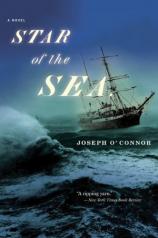Reading Group Guide
Discussion Questions
Star of the Sea

1. Star of the Sea begins with four introductory quotations, or epigraphs. Comment on how each of the epigraphs relates to this novel.
2. Who is telling this story (or, more aptly, these stories)? What do we know of the narrator at the outset, and what do we come to learn about him? Also, discuss whether and where the book-within-a-book structure enhances the novel's key themes and ideas.
3. David Merridith and Mary Duane are perhaps the only two characters whom we encounter as both children and adults. (Can you think of any others?) How do David and Mary change over the course of the book? How do their identities as adults reflect or refract their younger selves? More generally, what comments or concepts about childhood did Star of the Sea suggest to you?
4. One reviewer of this novel has claimed, "Pius Mulvey deserves a place among the classic villains of literature." Do you agree?
5. Describe the mystery that informs this novel-especially its last few chapters. Who is the murder victim? Who is/are the murderer(s)? Who are the suspects? What are the clues? What are the red herrings?
6. Discuss how the novel explores the phenomenon of creativity, especially as it relates to language, names, lyrics, stories, poems, etc. Does the novel suggest that the writing of history is also a creative act? Is a truly objective version of history either possible or desirable?
7. Star of the Sea has much to say on the subject of love (and, for that matter, sex). What kinds of love do we find in this novel? And what kinds-if any-are downplayed here, if not entirely lacking?
8. Investigate the role played by Charles Dickens in this novel-as a minor character and, perhaps, as a literary influence on both Grantley Dixon and Joseph O'Connor. What other Victorian authors, in your view, might fit logically and convincingly into these pages a la Dickens?
9. Look again at the incantatory poem that comprises Chapter XXVII. What do you make of this puzzling litany? What does it mean? Who composed it? (And can you translate the Latin "Ora pro nobis" phrase?)
10. The last sentence of this book reads: "All the way back to Cain." Which characters in this novel might be seen as representations of the Cain and Abel paradigm? Identify specific scenes or dialogue to make your points.
11. Look again at the date that appears below Dixon's signature at the end of Star of the Sea. What is the significance of this date, both in terms of history and in the context of O'Connor's narrative?
12. The sea voyage that defines this novel is a journey to America, which in the nineteenth century was not only the land of opportunity but also the world's great melting pot. But the eponymous ship itself is likewise a melting pot. Compare the different cultures, ethnicities, and social classes presented in these pages.
13. Compare how America is depicted in Star of the Sea-and how it is diversely understood by the main characters-with how you think America is perceived today, both at home and abroad.
14. James Kincaid in the New York Times commented, "This is a brave and artful novel disguised to appear safe and conventional." Is this true? In what ways, and for what purposes, does the author disguise his novel?
Star of the Sea
- Publication Date: March 8, 2004
- Genres: Fiction, Historical Fiction
- Paperback: 432 pages
- Publisher: Mariner Books
- ISBN-10: 0156029669
- ISBN-13: 9780156029667







